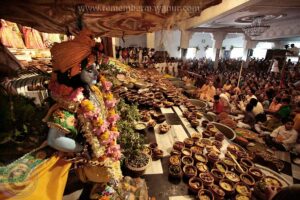Full lecture transcription [Link not active yet]
- The rules of begging.
- Brahmana starts begging with bhavati - first respect, then activity, then result.
- Kshatriya first states the activity, then respect, then result.
- Vaishya fist states the benefit, then activity, then respect.
- Within upanayanam samskara first alms are given by mother, sister or aunt, so it turns out auspicious.
- Prasada may be honored sitting in any direction.
- While eating one should be focused on the prasada. No discussions distracting from the meal should be entertained.
- Eating is not maya, maya is not seeing things in connection to Krishna.
- Austerity on its own is not devotional service. Good things on their own are not devotional service. It becomes devotional service when we understand the connection to Krishna.
- One should eat what one is happy about.
- Food eaten in worshipful mood gives good health and nourishment, neglectfully - vice versa.
- We should never eat with people who complain about what we are eating.
- There is no healthy health food freaks.
- The laws given in the Manu Samhita are not an option, they are laws. Some laws don't apply to Vaishnavas as a lifestyle, ashrama. But in varna all the rules given apply.
- We follow laws everywhere else, but we question God's laws. If we are scared, we should not stay in this class.
- People who are materially regulated are generally healthy because they unknowingly follow God's laws.
- Manu tells us not eat between meals.
- One should not overeat oneself, but should try to feed others as much as possible.
- Overeating is impediment to health, fame and way to heaven.
- Brahmana sips water from the base of the wrist, root of the thumb. For demigod, pitri worship etc there are other places to sip from.
- Acamana is a Vedic ritual that is used in Pancaratra.
- Acamana should be performed facing East or North.
- Water should be clean and cool.
- Brahmana is purified when acamana water reaches his heart - that happens when one uses the right quantity and concentrates. That focus ensures the purity of the brahmana. Shudra is purified when water merely touches the lips.
- Those who worship Vishnu always wear thread on the left shoulder to the right, and expose right arm and shoulder while wearing chaddar. For other worships it is vice versa.
- Sacred items are placed in water after use. Burning or burying is the next option.
- First 6 chapters of Manu Samhita are going in the order of samskaras.
- Keshanta - clipping hair, confirming student's vows. Brahmana is mature at the age of 16. One shows one's own commitment and desire to study, as opposed to just what parents wanted. Brahmanas continue to study, while kshatriyas and vaishyas usually graduate at the age of 16.
- Ceremonies for females are performed chanting mantras without svaras. For women, upanayana is replaced by marriage.
- Women don't have the ceremony of keshanta. For women the conviction to remain unmarried is not important, since girls are always focused in what they are doing.
- Marriage is equal to initiation for women. Serving the husband is equal to service to the teacher. Household duties give the same benefit as performance of yajnas.
- Vedic is equal because everyone gets the same benefit, even though the means may be different.
- It's not that men and women like exactly the same things in the same way.
- 44:30 Women want to give a class. What result are they looking for?
- To give class just because one is a woman is quite bodily conscious.
- When men do something the formality is great. When women do something, they always involve some art. Therefore there are things that only men do, since women would not be satisfied with them anyway - there is no aspect of art there.
Topic 3 The ordinances of studentship
- First teacher instructs the student in personal purification and conduct. Next is yajna, Deity worship and chanting of mantras. After that comes study.
- While offering obeisances, hands are put on top of each other and crossed (as if touching the right foot of the teacher with right hand, left foot with the left hand.)
- The brahmana teacher must always be enthusiastic to teach. If student doesn't learn they repeat it.
- Lesson should start with transcendental sound, otherwise knowledge will slip away, and end also, otherwise knowledge will fade.
- We chant "Om" before Hare Krishna to catch people's attention and to get everyone on the same note.
- AUM represents the three Vedas, three worlds, three padas of Gayatri, the Lord, His internal potency and the living entities.
- By chanting Gayatri one gets the benefit of reciting the whole Veda.
- Gayatri is chanted morning and evening with all the accompanying rituals, but at noon simply purification and chanting takes place. Therefore sometimes it is misunderstood that Gayatri is chanted twice a day.
- 60:30 Wrapping the thread around thumb while chanting Gayatri - it is meant for those who chant Gayatri as japa, many times, to help counting.
- 63:00 Portals before internet.
- Chanting of Gayatri is entrance into study of the Veda and into transcendence.
- Brahma Gayatri removes the purusha-bhava. Therefore women traditionally would not chant it.
- Prabhupada did not want to give Brahma-gayatri to women, but they went on strike, and Prabhupada decided that they had as much purusha-bhava as men, so it would help. But technically it is not a glory.
- Don't use dharma to establish adharma, use dharma to establish things the way they work.

